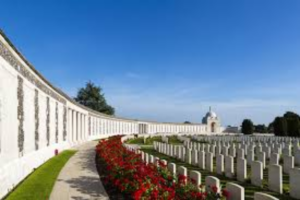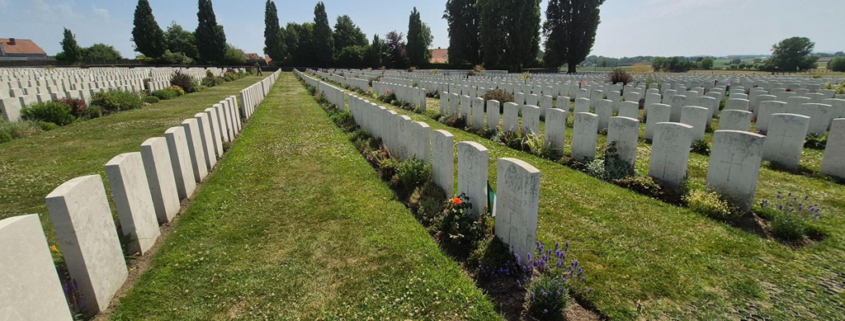Battlefields Trip 2025
 Our Year 8 Students have just returned from a thought provoking day trip to the Battlefields in Belgium. Dexter and William tell us more…
Our Year 8 Students have just returned from a thought provoking day trip to the Battlefields in Belgium. Dexter and William tell us more…
From the 13 June to early the following morning, a number of students visited a few Belgian battlefields. This trip was a one of remembrance as well as of learning, vital to not repeat our past mistakes and to respect the fallen that fought to keep the world a free place.
The first destination that was visited was The Essex Farm Memorial, slightly to the North of Ypres, where the students’ tour guide was picked up. While there, the tour guide gave a lecture about the site and explained that the site had been an “advanced” medical facility. The supposed medical facility was just a hole dug into the ground with a sheet of corrugated iron placed on top. Most of the cemeteries’ buried individuals were patients of the facility. They either died on the spot or were buried after the surgery to save them was unsuccessful. The famous poem In Flanders Fields was inspired here, written by Canadian physician Lieutenant-Colonel, John McCrae, after his friend had been killed and buried. Presumably displeased with his work, McCrae discarded the poem – only for it to be found by a soldier and later published as a call to arms.
Second on the agenda was The Langemark German War Cemetery, again to the North, but quite a lot further. Here the students learnt about the 3,000 school children that were killed in The First Battle of Ypres and the stupendous 44,000 soldiers buried in such a small yard. At The Second Battle of Ypres, 22 April 1915, the first gas attack was made using chlorine gas, at the site of the cemetery. The entire atmosphere of the memorial was quite solemn as if in mourning, yet it gave a calm atmosphere to respect the soldiers.
The penultimate location, Tyne Cot, Northern Zonnebeke, is the largest Commonwealth cemetery in Europe. Nearly the entire memorial is made of white stone and offers an awe-inspiring view that struck a solemn respect for the resonance of brilliant white stones stretching for a quite way into the distance. Though there are many graves, the majority of the fallen are marked not with a headstone, but rather with their names are inscribed into a vast wall that records the names of all the soldiers whose bodies were not recovered. Standing at the main memorial statue looking to a windfarm, (where the tour started) you can see the distance that the British covered in their battles. Over the distance of 5 miles (or 8 kilometres) the British lost 6 soldiers per metre. A devastating, tragic loss. Truly this place is a centre for reflection, admiration, and remembrance. A simply breath-taking experience.
The last stop on the tour around the battlefields was the Memorial Museum Passchendaele 1917. It showcases a variety of different implements of war including: rifles, pistols, artillery (and its shells), grenades and documents of strategy. As well as this, there was an assortment of garments ranging from hats to uniforms and helmets. Also, there was the remains of an iron German Eagle, that looked quite menacing. Also in the museum were imitation trenches that gave a good idea of the cramped conditions and the stooped posture the soldiers would have had to perpetually remain in. There were even artillery stores and a periscope to give an even more realistic tone to the trenches and truly show what they were like.
In summary, the trip was heart-wrenching and heart-warming in unity, for the sheer magnitude of some of the cemeteries almost moved me to tears but it was also relieving to see these acts of remembrance solidified in memorial form. I would heartily recommend any Year 7s thinking of going, to go. This trip is a once in a lifetime opportunity that cannot be missed. It is about remembrance.
Lest we forget.
Dexter Brown (8C3)
On Friday 13 June, 101 Year 8’s took a day trip to the Ypres battlefields. The Battlefields trip was a great experience. There wereSo many different places to commemorate the ones of the past and the tour guide gave us the inner details and stories of those who are in the graves. It shone light on the true horrors of the war and it was an actual representation of the scale of casualties in the Great War. We got to see how the victors’ men were treated after and how their enemies were treated after the dust had settled. It was a good opportunity to pay respects to those who fought for us. We went to the Passchendaele museum, Langemark German war cemetery, Tyne Cot cemetery and Essex Farm cemetery. Each location revealed more and created a greater picture and told us about the men who fought for freedom and peace. They were brave, they were ambitious, they were trustworthy soldiers who could be believed in to succeed. We are now safe because of them.
William Welch (8P2)




